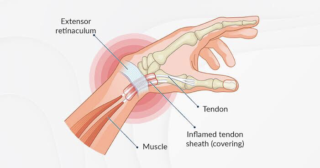CONDITIONS
Medical Conditions we treat:
- Musculoskeletal Conditions
Joints & Bones
Frozen Shoulder (Adhesive Capsulitis)
Bursitis
Dislocated Shoulder
Post Surgical Rehabilitation
Knee Pain
Osteoarthritis
Condramalacia Patella
Joint Stiffness
Neck & Spine
Neck Pain & Stiffness
Spondylitis
Low Back Pain
Sciatica
Degenerative Disc Disease(DDD)
Herniated Discs(Bulging Discs)/Slipped Disc
Spondylosis
Scoliosis
Piriformis Syndrome
Posture problems
Muscles
Spasm
Fibromyalgia
Rotator Cuff Injuries
De Quervain’s tenosynovitis
Trigger Finger
- Neurological conditions
- Sports injury conditions
De Quervain’s tenosynovitis
One of the most common types of tendon inflammation, de Quervain’s tendinosis (also called de Quervain’s tenosynovitis) is a painful swelling (inflammation) of specific tendons of the thumb.When this happens, you may lose the ability to move your thumb and wrist normally. De Quervain’s tendinosis can be caused by overuse, repetitive grasping or inflammatory conditions like arthritis.

Tendons are bands of tissue that attach muscles to bones. Usually tendons slide easily through a tunnel of tissue called a sheath. The sheath keeps the tendons in place next to the bones of the thumb. Tendons that easily slide through their sheaths allow the thumb to move without difficulty or pain. The pain may extend from the forearm to the thumb base.
Any swelling of the tendons and/or thickening of the sheaths cause friction. The tendons can no longer easily slide through their sheaths. When this happens, certain thumb and wrist motions become more difficult to do.
This condition affects women eight to 10 times more often than men.
Causes
De Quervain’s tendinosis can be triggered by several factors, including:
- Overuse.
- A direct blow to the thumb.
- Repetitive grasping.
- Inflammatory conditions (including arthritis).
Activities that require a sidewise motion of the wrist while you are gripping with the thumb can aggravate this condition. Hobbies and sports that use this motion include:
- Lifting young children.
- Gardening
- Racquet sports (tennis, racquetball).
- Skiing
- Using a hammer.
Often, the exact cause of de Quervain’s tendinosis is unknown.
Symptoms
Symptoms of de Quervain’s tendinosis can include:
- Pain and tenderness along the side of the wrist on the thumb side.
- Pain that gets worse as you use the hand and thumb.
- Pain that appears suddenly or develops over time.
- Pain that travels into the thumb or from the wrist to the lower arm (forearm).
- Pain or difficulty when moving the thumb, especially when grasping or pinching objects.
- Feeling snapping or popping sensation in the wrist when moving the thumb.
The test most often used to diagnose de Quervain’s tendinosis is the Finkelstein test. Your doctor will ask you to make a fist with your fingers wrapped over your thumb. Keeping your hand in a fist position, the wrist is moved up and down — the motion of shaking someone’s hand. In this test, the swollen tendons are pulled through the narrowed sheath. If this movement is painful, you may have de Quervain’s tendinosis.

